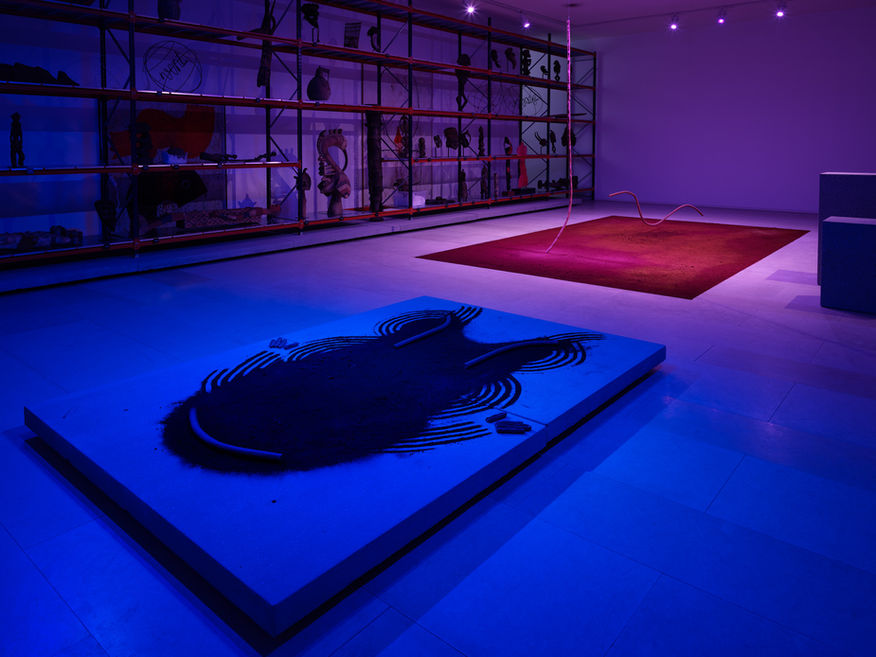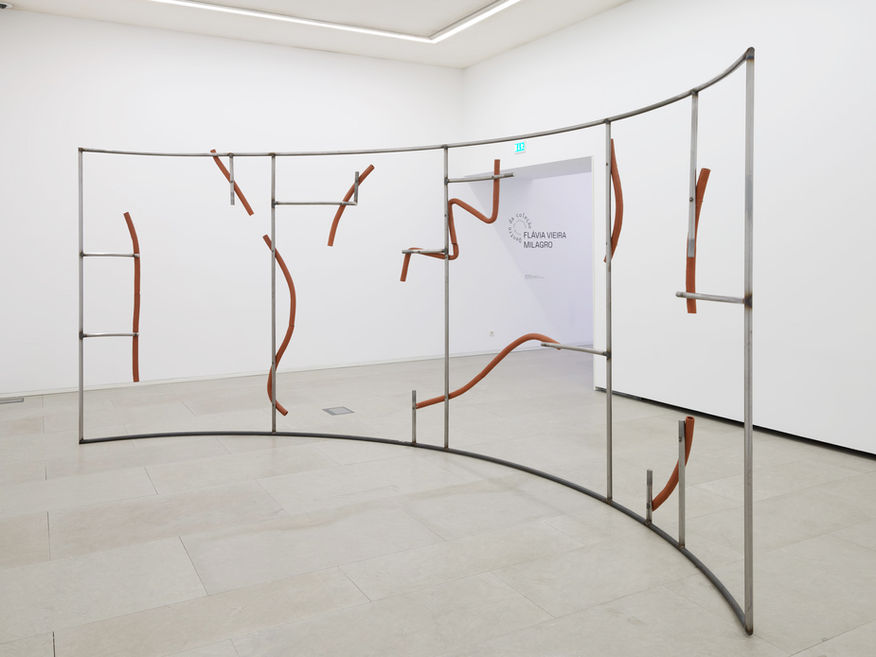top of page
Milagro - Inside the Collection
Curated by Marta Mestre and João Terras
Centro Internacional das Artes José de Guimarães - CIAJG
Guimarães, Portugal
https://www.ciajg.pt/detail-eventos/20241207-flavia-vieira-milagro/
Iron oxide, indigo, cochineal, ceramic, brass, steel and gold
2024
@ Filipe Braga
When we encounter artistic work inspired by age-old handicraft processes we inevitably ask: how can an artist sensitively appropriate the scarce materials that remain available? This question is a bit like water spilt on arid ground, given the vertiginous (and dry) nature of the present-day experience. The truth is that formulating this question is nothing new and that a similar level of aridity has prevailed at other times in history, especially in the chaotic post-war period, when artists joined forces to untangle the heterogeneous threads of that time and then weave them back together, based on a pattern and meaning that united modern and ancestral dimensions.
But the final echo of utopian world views has now given way to a sense of loss.
Miracle stretches the thread which unspools from this question, which is as legitimate to formulate as it is difficult to answer. Flávia Vieira is well aware of its historical dimension, especially in terms of dialogues between pre-Columbian cultures and the artistic practices that, over time, have drawn inspiration from these symbolic and material universes. She also realises that in the present day, beyond the revolutionary project of the avant-garde - which projected a new humanity based on a new sensorial and technical arrangement of the world - the weft that tries to interweave reality is now unravelling and becoming frayed.For all these reasons, Flávia Vieira is keen to present Miracle as an exploration – forging an open and contingent dialogue with the museum collection’s pre-Columbian artefacts. The thirty- three objects derive from the Inca, Chimú, Chancay, Moche, Aztec, Nicoya, Misteca, Talamameque and Nayarit cultures, which occupied part of the territory of Central and South America, and pertain to the chronological period approximately between 500 BC and 1532 AD.
Flávia Vieira views natural materials and traditional handicrafts as both a substitute for a vanished experience, and also a means of re-establishing it, notwithstanding the loss and in the face of the ongoing joy of making things for no reason in particular.In interspersed rooms, she creates two types of sculptural and installation-based presence. On the one hand, a “sky map” or symbolic diagram, of interconnections and correspondences, in the form of a vertical field of vision; and on the other, the suggestion of a funeral space on the ground, a colourful trail of human presence. As two poles of the same interpretation of the world, they offer subtle material evidence to the spectator, an almost evanescent but nonetheless binding form of reconnection. An attempt to bend or stretch time. The plasticity of time can also be related to the body and its encounter with something else, thereby endowing a form, or leaving marks.
Flávia Vieira is essentially interested in the natural pigments that she uses in this work. Recently, she has become interested in traditional dyes and the symbolic properties of certain colourants, such as pitch black, which was brought from the “New World”, and began to be used by the Spanish aristocracy and royalty as the ultimate symbol of prestige. At the CIAJG, she uses pigments such as cochineal, indigo or iron oxide to compose an alchemy of colour. She uses each pigment to weave a profound narrative, in which the colours evoke different worlds and voices, and where the tones are deposited in multiple layers, like the sediments of a living history. Flávia’s proposal is therefore an archaeology of the gaze, excavating memories that are stored by the earth itself, while reorganising this matter into new compositions, tracing drawings and vestiges that reveal themselves in the dust of the pigments.
We must remember that pre-Columbian Americas had a dense and continuous socio-cultural fabric, and that the linguistic clash between peoples who were meeting for the first time led to the loss of the original meaning of things. The context surrounding the local plants, paint, feathers, manioc, spirits, dreams, wood, beads and people was rapidly distorted in order to transform them into exportable and desirable commodities. The process of economic trafficking dismantled the primordial links that connected people and objects, the visible and the invisible. In a letter written to the King and Queen, from La Española, in around 1498, Christopher Columbus announced:
“From here you can send all the slaves that one could possibly sell and brazilwood (a red-coloured wood); to the best of my knowledge, I am told that it will be possible to sell four thousand slaves, which, even at a low price, would be worth twenty contos; as well as four thousand quintals of brazilwood, which could be worth an equivalent amount.”
Milagro, in Spanish, is milagre (miracle) in Portuguese. The word can be reminiscent of the miracles of faith, the processions and pilgrimages that led fervent pilgrims to praise relics (as during the Franco and Salazar dictatorships in Spain and Portugal). But it also simply means “marvelling” at an extraordinary event, a sight that is filled with emotion. In this case, it is the colours that participate in the “miracle”, their integration into the spiritual and social fabric of pre-Columbian societies, as a cultural language that communicated values, beliefs and cosmological principles.
Cochineal, indigo and iron oxide.
Marta Mestre

bottom of page













